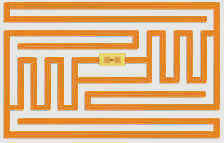 Brief Description: Short for Radio Frequency Identification, RFID uses tags with embedded radio signals to identify objects. A separate RFID reader or interpreter must be used to translate the data contained in the tags. The small RFID tag consists of a circuit for storing information and an antenna for transmitting this information. Passive tags have no power supply and can be manufactured as stickers to place inside books. Passive tags have a short range and the RFID reader must be within a few meters to pick up the signal transmission. At the left is an image of an RFID tag from the Wikipedia article about this technology.
Brief Description: Short for Radio Frequency Identification, RFID uses tags with embedded radio signals to identify objects. A separate RFID reader or interpreter must be used to translate the data contained in the tags. The small RFID tag consists of a circuit for storing information and an antenna for transmitting this information. Passive tags have no power supply and can be manufactured as stickers to place inside books. Passive tags have a short range and the RFID reader must be within a few meters to pick up the signal transmission. At the left is an image of an RFID tag from the Wikipedia article about this technology.How is it used in a library? Libraries can use this technology to track library materials. RFID tags placed on library materials can be used for circulation, security, shelving, and usage statistics. RFID tags do not operate on line of sight as do traditional barcodes used for circulation, so multiple items can be checked out at one time. RFID tags can be embedded with a security signal that activates corresponding RFID security gates if material has not been checked out. There are smart shelving units available that use RFID technology to keep track of the books which are supposed to be on them, identify books placed in the incorrect order, and which can even track how many times an item is removed from the shelf and replaced by the user. Even without the smart shelves, RFID tags can be used to inventory and locate mis-shelved materials when someone walks by with an RFID reader.
Expected Social Impact: RFID has the capacity to greatly simplify many library activities both for the librarian and the patron. Unfortunately, RFID faces challenges for widespread implementation because of feared privacy violations. And indeed, if put to the wrong use, RFID has the potential to turn our world into some version of "Minority Report" with people being tracked through embedded tags and marketing materials aimed specifically at passing individuals. This is an extreme scenario and certainly something out of reach of the passive tags used for library materials, which are little different privacy-wise than the barcodes already in use. The real expected social impact is the steadily decreasing need for contact with another person when carrying out transactions. RFID tags are already in use for "smart pass" debit cards and automatic toll deductions. In libraries, RFID tags could greatly simplify the self-checkout process and greatly reduce the amount of time needed to check out a large amount of material.
No comments:
Post a Comment